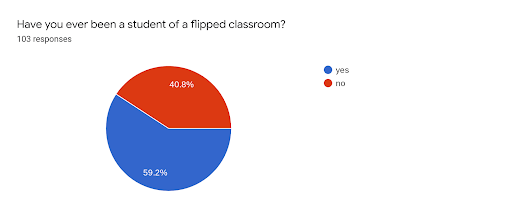Flipped Classroom: Pros and Cons
In an age where technology’s integration into the classroom is prominent, unconventional methods of teaching are being introduced. Some teachers are adapting to the rapidly growing digital world and using the internet as a tool. The semi-new method of teaching a flipped classroom has already crept into our school. A flipped classroom as defined by the internet is described as instructional content being delivered outside of the classroom, often online, while the activities previously considered to be homework are worked on in the classroom. I was interested in the pros and cons of flipped versus traditional classrooms, so I decided to interview one flipped classroom teacher, and one teacher with a traditional teaching style.
Interview with Mr.J (Algebra 2, Calc, Computer Science, PFM)
What do you define as a flipped classroom?
A style of teaching in which the content of the course is presented at home (a lot of the time through videos) and the course “homework” is done in class.
When did you first hear of this teaching method?
I don’t know when I first heard of the term but I began teaching a flipped classroom right off the bat at my first job in Sharon Springs. It was 2012.
Was your flipped classroom successful at first?
Yes very successful, my first year teaching Algebra 2 100% of the students passed the regents and 40% had mastery.
Have you ever been a student in a flipped classroom?
No, I liked math growing up but it was really boring. Math is an inherently boring subject. I know I’m a boring person, so why would I make you bored.
Is there a type of student that does not perform well in a flipped classroom?
The style of teaching is very self serving. If you are a motivated student you tend to do well. Unmotivated students tend to struggle a little bit more.
What subjects, if any do not work well in a flipped setting?
Content heavy classes are the ones that work because the content can be put into videos for home learning. More skill based classes, like English, would not work. My Algebra 2 and Calculus classes are flipped. My computer science and personal finance classes are not flipped because they would not function well. Speaking of personal finance, take PFM kids.
Was there a learning curve involved when making and editing your video notes, and what software do you use?
Yes, I had no idea what to do at first. Some of the first video notes are very bad. I use “Educreations”.
Interview with Mr. Darlington (High school Chem, College Chem, Physics)
Most students at Galway would describe your teaching methods as traditional, would you agree with this statement?
Yes and no. My classroom is traditional in that class time is structured, has clear expectations, and a lack of surprises.
What are you talking about? Yesterday we walked into class and started burning sand for a lab without any direction.
The goal for my classroom is not “are my students getting good grades” it’s “are my students learning”. Real life has no checklist, which is why labs are often left open ended.
In our school you have a reputation for being less enthused about technology than other teachers, tell me about that?
First of all something I tell all of my students is that if you can’t think critically you are either going to be replaced by a machine or outsourced as far as the workforce goes. I use technology when it solves problems, which is not as often as most people think.
I’m guessing this mentality is directly linked to the decision to get rid of your SmartBoard?
Yes, I got rid of my SmartBoard because it didn’t solve any problems. I did not increase the amount of kids doing their homework, nor did it increase classroom engagement. The projector I replaced it with does just what I need it to, it gets info out to the class quickly.
Do you know what a flipped classroom is and would you ever adopt that way of teaching?
I have always made it an option for a student to flip my class if they want to. All of the notes are on the website and they could copy those down at home and just come in, sit at the lab tables, and ask questions when needed. The thing is, almost no one ever chooses to do this. Students like doing the notes in class and benefit with the instruction that comes with copying them in class. The goal of this class is for students to be challenged according to their own needs.
After speaking with both teachers, it is clear there are benefits and downfalls of both methods of teaching. The students that thrive in these classrooms are probably very different from one another. Overall I think that no matter what, highly motivated students will do well in either setting, but I definitely think there is a preference among my peers on how material is presented. Some love the flipped classroom, including myself, because it allows a lot independence. Others prefer traditional teaching because it is sometimes easier to follow and allows the opportunity to ask questions in the moment.
In a research paper written by Dr.Robert Talbert in which he reviews research papers on the topic of flipped classrooms he comes to the conclusion that “The vast majority of the (research) papers reviewed show either higher scores than students in traditional settings, or else the differences are not statistically significant”,(http://rtalbert.org/what-does-the-research-say/). Talbert also noted that although higher scores have been exhibited,”when flipped learning students outperform traditional students, the effect size is usually fairly modest”,(http://rtalbert.org/what-does-the-research-say/). It should also be noted that Talbert thought the majority of the research papers measured the success of flipped classrooms in quantitative measurements instead of qualitative measurements which he believes to be less accurate. Talbert also thought that a lot of the papers were biased towards flipped classrooms in that they were trying to “sell” teachers the flipped classroom method. Although this article claims that any increase in test scores is modest, if a flipped classroom is how the students prefer to learn the content, why would you deny presenting them the information that way?
In another research paper published by Bowling Green State University, Raymond Szparagowski discusses how he tested the effectiveness of flipped versus traditional teaching styles in his student teaching classes. Szparagowski taught four days of traditional teaching and four days of flipped teaching and then surveyed the students after each block of four days. His findings included the data that a wider range of his students felt more confused on the flipped classroom homework than the traditional homework. His findings also included a 14% difference in scores. The traditional classroom test had a class average of 68% and the flipped classroom quiz had an average grade of 82%. However, Szparagowski claims that,”this grade does not show that students will get significantly better grades on the flipped than in a non-flipped classroom. Much of this difference can be attributed to the larger size and greater difficulty of the test”,(https://scholarworks.bgsu.edu/cgi/viewcontent.cgi?article=1118&context=honorsprojects).
Unfortunately as I sifted through various papers and websites, a lot of the tests conducted on the effectiveness of the two teaching styles had the same disclaimers as the last two articles. There is simply no easy way to conduct an unbiased classroom test that has enough constants to keep the data unskewed from anything besides the teaching style. So many things are at play, from the lack of home internet access for some students, to a bad day where too many students are being disruptive during an in class lecture. I also don’t think that simply analyzing scores is enough to prove anything. The quality of learning is what should be analyzed, and that is simply said, a very difficult thing to judge.
Our Student Body
From what I’ve heard in general, our students have had a positive experience with flipped classrooms, but I haven’t reached a broad enough audience to determine a general consensus. I decided to collect some actual data through an anonymous poll sent out to every student grades 7-12. The pie graphs produced from the data are pictured below, but here’s a general summary. 59% of people polled said they have been a student in a flipped classroom before, and of the 41% who have not been in a flipped classroom yet, 58% said they’d be willing to try it. The majority of people said that the flipped classroom improved their grades, and 63% said that they preferred the flipped classroom, or simply said they had no preference. The majority also said that classroom engagement was improved. Overall I think this means that in our school, flipped classrooms are resulting in positive and neutral effects.
Here are some additional comments you guys left when polled…
~I LOVED my flipped classroom experience with Mr. Jacaruso!!
~More engaging than regular class
~Personally, I prefer a teacher to be in the front of the classroom teaching. I felt that while using flipped
classroom, i wasn’t fully understanding the topics and I became easily distracted or off-task.
~MR J FLIPPED CLASSROOM IS THE GOODEST THING EVER
~I have two experiences with flipped classroom. One was extremely successful, while the other was not.
~It depends on how the teacher is willing to put into the videos and learning material you are assigned out of school hours for the in school hours to pay off.
~I am better at focusing on information in a school environment, learning at home makes me not remember the information as well.
~flipped classrooms are harder to understand and may make learning harder. some students need to teacher to student connection to understand the topic.
~I personally prefer the flipped classroom more than to a regular classroom setting.
~I love having a flipped classroom and being able to ask the teacher questions in class
Do you have a comment on the flipped classroom? Please leave it below!
Works Cited
Szparagowski, Raymond, “The Effectiveness of the Flipped Classroom” (2014). Honors Projects. 127. https://scholarworks.bgsu.edu/honorsprojects/127
Talbert, Robert. “What Does the Research Say about Flipped Learning.” Robert Talbert, Ph.D., Robert Talbert, Ph.D., 21 Aug. 2018, rtalbert.org/what-does-the-research-say/.

Anna enjoys writing thought provoking articles and is also one half of the "Anna Show". She participates in volleyball, track, robotics, jazz band, GTV,...

